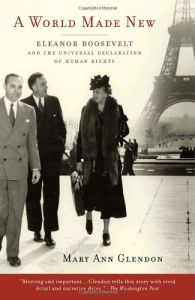
A World Made New
Eleanor Roosevelt and the Universal Declaration of Human Rights
ISBN: 9780375760464
Pages: 368
Recommendation
How did a standard of international human rights come into being? What threatens this standard today? Harvard law professor and former US Ambassador Mary Ann Glendon’s scholarly overview of the Universal Declaration of Human Rights, its authors and the debates that surround it addresses these questions in detail. Glendon’s text focuses on how Eleanor Roosevelt and her peers on the Human Rights Commission (particularly, Peng-chun Chang, René Cassin and Charles Malik) framed the work – collaborating across cultures and worldviews to yield an inspiring document to protect all people. In so doing, the book touches on important themes, including universality, multiculturalism, translation and political ideologies. The first chapters cover the process of creating the Declaration, providing insight into the practical complexities of drafting the text. Glendon then shifts to discussion of the Declaration’s content. Though a timeline and other editorial notes would help the overall fluidity and clarity of the sometimes dense material, it is a valuable read for anyone interested in understanding human rights.
Summary
About the Author
Mary Ann Glendon is the Learned Hand Professor of Law at Harvard University. She was a former United States Ambassador to the Holy See and served as president of the UNESCO-sponsored International Association of Legal Science.









Comment on this summary